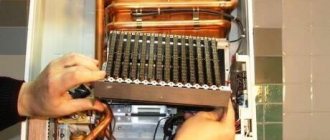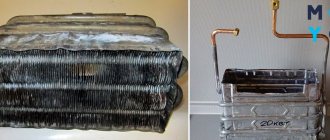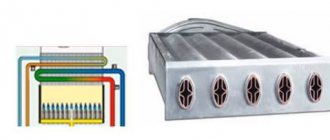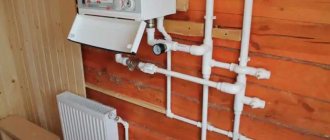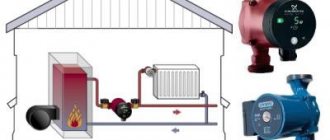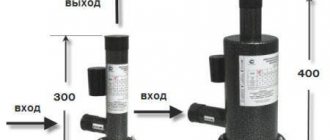Organization of hot water supply is one of the main conditions for a comfortable life. There are many different installations and systems for heating water in a home DHW network, but one of the most effective and economical is the method of heating water from a heating network.
Heat exchanger for hot water
selected individually, based on the owner’s requests and the capabilities of the heating equipment. Correct calculation and proper installation of the system will allow you to forget about interruptions in hot water supply forever.
Application of plate heat exchanger for hot water supply
Heating water from the heating network is completely justified from an economic point of view - unlike classic water heating boilers using gas or electricity, the heat exchanger works exclusively for the heating system. As a result, the final cost of each liter of hot water is an order of magnitude lower for the homeowner.
A plate heat exchanger for hot water uses the thermal energy of the heating network to heat ordinary tap water. Heating from the heat exchanger plates, hot water flows to water collection points - taps, mixers, shower in the bathroom, etc.
It is important to take into account that the coolant water and the heated water do not come into contact in any way in the heat exchanger: the two media are separated by the plates of the heat exchanger through which heat is exchanged
.
You cannot directly use water from the heating system for domestic needs - it is irrational and often even harmful:
- The process of water treatment for boiler equipment is a rather complex and expensive procedure.
- To soften water, chemical reagents are often used, which have a negative impact on health.
- A colossal amount of harmful deposits accumulates in heating pipes over the years.
However, no one indirectly prohibited the use of water from the heating system - the DHW heat exchanger has a fairly high efficiency and will fully meet your need for hot water.
Requirements for gaskets
To ensure complete tightness of the profile channels and prevent leakage of working media, sealing gaskets must have the necessary heat resistance and sufficient resistance to the effects of an aggressive working environment.
The following types of gaskets are used in modern plate heat exchangers:
- ethylene propylene (EPDM). Used when working with hot water and steam in the temperature range from -35 to +1600C, unsuitable for fatty and oily environments;
- NITRIL gaskets (NBR) are used for working with oily working media, the temperature of which does not exceed 1350C;
- VITOR gaskets are designed to work with aggressive working environments at temperatures not exceeding 1800C.
We recommend: Do-it-yourself insulation of the ceiling in a bathhouse - several affordable methods
The graphs show the dependence of the service life of seals on operating conditions:
As for attaching the sealing gaskets, there are two ways:
- on glue;
- using a clip.
The first method is rarely used due to the complexity and duration of installation; in addition, when using glue, maintenance of the unit and replacement of seals is significantly more complicated.
The clip lock ensures quick installation of plates and ease of replacement of failed seals.
Types of heat exchangers for domestic hot water systems
Among the many types of different heat exchangers, only two are used in domestic conditions - plate and shell-and-tube. The latter have practically disappeared from the market due to their large dimensions and low efficiency.
Plate heat exchanger DHW
is a series of corrugated plates on a rigid frame. All plates are identical in size and design, but follow each other in a mirror image and are separated by special gaskets - rubber and steel. As a result of strict alternation between paired plates, cavities are formed, which are filled with coolant or heated liquid - mixing of media is completely excluded. Through the guide channels, two liquids move towards each other, filling every second cavity, and also, along the guides, exit the heat exchanger giving/receiving thermal energy.
The higher the number or size of plates in the heat exchanger, the larger the useful heat exchange area and the higher the performance of the heat exchanger. Many models have enough space on the guide beam between the frame and the locking (outer) plate to install several plates of the same size. In this case, additional plates are always installed in pairs, otherwise it will be necessary to change the inlet-outlet direction on the locking plate.
Scheme and principle of operation of a hot water supply plate heat exchanger
All plate heat exchangers can be divided into:
- Collapsible (consist of separate plates)
- Soldered (sealed housing, not dismountable)
The advantage of collapsible heat exchangers is the possibility of modifying them (adding or removing plates) - this function is not provided in brazed models. In regions with low quality tap water, such heat exchangers can be disassembled and cleaned of debris and deposits manually.
Brazed plate heat exchangers are more popular - due to the lack of a clamping structure, they have more compact dimensions than a collapsible model of similar performance. selects and sells brazed plate heat exchangers from the world's leading brands - Alfa Laval, SWEP, Danfoss, ONDA, KAORI, GEA, WTT, Kelvion (Kelvion Mashimpex), Ridan. From us you can buy a DHW heat exchanger of any capacity for a private house or apartment.
The advantage of soldered heat exchangers compared to collapsible ones
- Small dimensions and weight
- More stringent quality control
- Long service life
- Resistance to high pressures and temperatures
Cleaning of soldered heat exchangers is carried out using the in-place method. If, after a certain period of operation, the thermal characteristics begin to decrease, then a reagent solution is poured into the device for several hours to remove all deposits. The break in equipment operation will be no more than 2-3 hours.
Design and principle of operation
The design of a gasketed plate heat exchanger includes:
- a stationary front plate on which the inlet and outlet pipes are mounted;
- fixed pressure plate;
- movable pressure plate;
- package of heat exchange plates;
- seals made of material that is heat-resistant and resistant to aggressive environments;
- upper supporting base;
- lower guide base;
- bed;
- set of coupling bolts;
- Set of support feet.
This arrangement of the unit ensures maximum intensity of heat exchange between working media and compact dimensions of the device.
Design of a gasketed plate heat exchanger
Most often, heat exchange plates are made by cold stamping from stainless steel with a thickness of 0.5 to 1 mm, however, when using chemically active compounds as a working medium, titanium or nickel plates can be used.
All plates included in the working kit have the same shape and are installed sequentially, in a mirror image. This method of installing heat exchange plates ensures not only the formation of slot channels, but also the alternation of primary and secondary circuits.
Each plate has 4 holes, two of which provide circulation of the primary working fluid, and the other two are isolated by additional contour gaskets, eliminating the possibility of mixing working fluids. The tightness of the connection between the plates is ensured by special contour sealing gaskets made from a material that is heat-resistant and resistant to active chemical compounds. The gaskets are installed in the profile grooves and secured using a clip lock.
Operating principle of plate heat exchanger
The effectiveness of any plate maintenance is assessed according to the following criteria:
- power;
- maximum temperature of the working environment;
- bandwidth;
- hydraulic resistance.
Based on these parameters, the required heat exchanger model is selected. In collapsible plate heat exchangers, the throughput and hydraulic resistance can be adjusted by changing the number and type of plate elements.
The intensity of heat transfer is determined by the flow regime of the working medium:
- with laminar flow of the coolant, the intensity of heat transfer is minimal;
- the transition regime is characterized by an increase in the intensity of heat transfer due to the appearance of turbulence in the working environment;
- The maximum intensity of heat exchange is achieved with turbulent movement of the coolant.
The performance characteristics of the plate heat exchanger are calculated for a turbulent flow of the working medium.
Depending on the location of the grooves, there are three types of heat exchange plates:
- with “soft”
channels (grooves are located at an angle of 600). Such plates are characterized by slight turbulence and low heat transfer intensity, however, “soft” plates have minimal hydraulic resistance; - with “medium”
channels (corrugation angle from 60 to 300). The plates are a transitional option and are distinguished by average turbulence and heat transfer rates; - with “hard”
channels (corrugation angle 300). Such plates are characterized by maximum turbulence, intense heat transfer and a significant increase in hydraulic resistance.
To increase the efficiency of heat exchange, the movement of the primary and secondary working fluid is carried out in the opposite direction. The heat exchange process between the primary and secondary working fluids occurs as follows:
- The coolant is supplied to the inlet pipes of the heat exchanger;
- When moving the working media along the corresponding circuits formed from heat-exchange plate elements, intense heat transfer occurs from the heated medium to the heated one;
- Through the outlet pipes of the heat exchanger, the heated coolant is directed to its destination (heating, ventilation, water supply systems), and the cooled coolant again enters the working area of the heat generator.
Operating principle of a plate heat exchanger
To ensure efficient operation of the system, complete tightness of the heat exchange channels is required, which is ensured by sealing gaskets.
DHW heat exchanger connection diagrams
The water-to-water heat exchanger has several connection options. The primary circuit is always connected to the distribution pipe of the heating network (city or private), and the secondary circuit is always connected to the water supply pipes. Depending on the design solution, you can use a parallel single-stage DHW circuit (standard), a two-stage mixed or two-stage sequential DHW circuit.
The connection diagram is determined in accordance with the standards of “Design of Heating Points” SP41-101-95. In the case when the ratio of the maximum heat flow for DHW to the maximum heat flow for heating (QDHWmax/QTEPLmax) is determined within the limits of ≤0.2 and ≥1, a single-stage connection diagram is taken as the basis, but if the ratio is determined within the range of 0.2≤ QDHWmax/ QTEPLmax ≤1, then the project uses a two-stage connection diagram.
Standard
The parallel connection scheme is considered the simplest and most economical to implement. The heat exchanger is installed in series with respect to the control valve (shut-off valve) and parallel to the heating network. To achieve high heat transfer, the system requires a large flow of coolant.
Two-stage
When using a two-stage heat exchanger connection scheme, water heating for DHW is carried out either in two independent devices or in a monoblock installation. Regardless of the network configuration, the installation scheme becomes much more complicated, but the efficiency of the system increases significantly and coolant consumption is reduced (up to 40%).
Water preparation is carried out in two stages: the first uses thermal energy from the return flow, which heats the water to approximately 40°C. At the second stage, the water is heated to a standardized level of 60°C.
A two-stage mixed connection system looks like this:
Two-stage serial connection diagram:
A sequential connection scheme can be implemented in one DHW heat exchanger. This type of heat exchanger is a more complex device compared to standard ones and its cost is much higher.
Why contact us
To solve non-standard situations related to heating a house, it is necessary to resort to the services of specialized installers who are fluent in their specialty. High skill and extensive experience allow specialists to perform the necessary work on installing heat exchangers efficiently and within the specified time frame.
| Monday | Open 24 hours |
| Tuesday | Open 24 hours |
| Wednesday | Open 24 hours |
| Thursday | Open 24 hours |
| Friday | Open 24 hours Now open |
| Saturday | Open 24 hours |
| Sunday | Open 24 hours |
